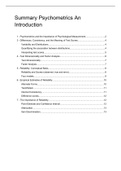Samenvatting
Summary Psychometrics An Introduction
This document contains the summary of chapters 1, 3, 4, 5, 6 and 7 of the book Psychometrics An Introduction the fourth edition by R. Michael Furr. A score of 9.5 was obtianed with this summary. This literature is part of the literature for the course Practical Training: Psychological Research. T...
[Meer zien]





